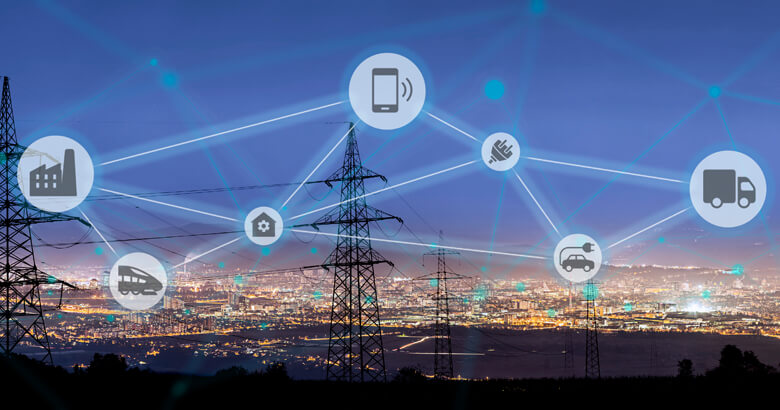Digitalisation in the Energy Industry, Part 3/3: Approaches, Drivers, Opportunities and Risks

As Germany’s energy industry is going greener, it is also going digital. Digitalisation provides many opportunities for simpler, more transparent processes. These include more efficient energy concepts, information in real time, intelligent use of data and new ways of doing business. However, how does being ‛always on’ impact the users? Do they really have control of their own data, and how are energy suppliers dealing with this issue? Our guest author Tobias Hevekerl, senior consultant at econtea GmbH, Berlin, takes a closer look at the opportunities and risks behind the digital transformation of the energy industry.
Opportunities and risks in going digital
Digitalisation opens up opportunities for a wide range of new business models. However, extensive use of mobile devices, increased digital networking, and the flood of data this entails can easily unsettle or overwhelm users. How can we find the right balance?
Nowadays, smartphones, tablets, laptops, smart TVs, etc. are an integral part of everyday life. We rely on several digital services, including calendar apps, online banking, GPS navigation and real time weather reports. They are faster and more efficient than the more traditional alternatives. However, these seemingly endless possibilities can make you feel permanently connected. How do you escape this flood of information? And what about the constant influx of new digital services? Users find themselves in a constant dilemma.[1] What should I use? What don’t I need? What will help me – and what won’t? This quickly gets overwhelming. Not to mention questions like – do I have control over my data? Are my personal details secure? How much information am I sharing, or will end up sharing?
Customers trust their energy providers – but we shouldn’t take that for granted
Energy suppliers are increasingly offering digital services to make life easier for their customers. Meter readings are sent digitally, whether for the annual bill or for a snapshot of current consumption. This data is used to create individual tariffs, which customers naturally receive digitally. Even changing your energy provider is purely digital these days. Energy suppliers are increasingly developing new business models and services from the wealth of data at their fingertips. For the most part, their customers view them as trustworthy institutions. They tend not to be concerned about sharing their data with them digitally. After all, they used to regularly put the same information into forms.
Energy suppliers should not take their customers‘trust for granted. When creating convenient, digital services for them, it is important to give data and IT security top priority.
What is driving innovation in the energy industry?
The main drivers are lower supplies of traditional fuel and the increasing willingness of customers to change provider. This high competition, coupled with digitalisation, leads to innovation.[2] A further factor driving innovation is decentralised energy providers.
Are there also barriers to innovation?
The barriers to innovation are a lack of personnel, and a high investment risk as it’s difficult to predict whether an innovation will be profitable. Equally, the complicated regulations in the energy industry do not help energy suppliers to innovate, while a low willingness to take risks by the more traditional energy providers mean that innovation may be approached quite slowly.
Digitalisation approaches and drivers
The digital transformation of the power industry and its new business models also pose challenges for the energy suppliers. There are several issues all along the value chain. Indeed, dealing with the mass of data generated is a challenge in itself. What can help?
What instruments are used in digitalisation?
Instruments often cited in the digital transformation of the energy industry include big data analytics, digital interfaces to customers (APIs) and cloud services. These naturally go hand in hand with data protection and IT security.[3]
Comparison websites are driving innovation in the energy industry
There is a growing number of new providers with new business models entering the energy market. In Germany, energy price comparison sites such as Verivox and Check24 are particularly well known. These and similar price comparison sites list energy suppliers and their products. This is an extremely useful sales channel as it is basically free advertising for the energy suppliers.
Moreover, the products themselves have essentially gone digital. Customers no longer have to go to a customer centre and fill out a form. Nowadays, switching to another energy supplier is done through the provider’s online portal, or at the least by e-mail. You can order electricity or gas products by app, making it easy for customers to switch.
The challenge for the power supplier is now to provide a reliable digital interface – an API – to these services. How can an energy provider quickly and efficiently share details on its products to these online comparison sites? How does it receive customers‘ orders from comparison sites? And how can it get these details into their backend systems and further along the value chain? Then, there’s also the connection to digital payment options (such as PayPal) or payment by credit card.
Germany’s digitalised energy industry is moving into the cloud
A modern, prominent solution to the above is cloud services. There are plentiful cloud services being offered by the tech giants, and many energy suppliers are already swapping their own IT infrastructure for cloud services. It’s more cost-effective, as they no longer need to set up and maintain their own IT infrastructure or server landscape. Cloud services can be easily booked and cancelled according to need, while computing power can be increased or decreased. The pricing models have also become very flexible.
As well as the tech giants, there are a number of smaller companies offering cloud services in Germany. These tend to be easily standardisable services. And that appeals to customers, as these are services they can simply book or cancel as they need them.
SEEBURGER offers a number of cloud services, including for e-invoicing and managed file transfer. SEEBURGER can also support you with your industry-specific services, such as with the communication service Mako Cloud and the energy regulator RRM+ Service, a reporting service which uses fully automated confirmation matching with trading partners and the European Transparency platform, to publicise insider trading.
In short
These days, it’s no longer enough for energy suppliers to develop and launch their own products and services. So that they can act flexibly within today’s smart networks, and develop new technologies for their customers, they need to be actively involved in cross-industry cooperations and ecosystems. This includes neighbouring industries such as telecommunications and mobility. However, more distant industries will also start playing a prominent role in the value chains behind the energy industry’s new business models. And this will ultimately lead to previously separate markets growing together. This offers opportunities, like learning from other industries. However, there are also obstacles. Many energy suppliers are only just starting to develop a systematic innovation process. And we can support you with our long experience.
[1] BDEW Bundesverband der Energie- und Wasserwirtschaft: Digitalisierungs aus Kundensicht. [Digitalisation from a customer perspective] (accessed 13.09.2021).
[2] cf. Germanwatch: Sechs Thesen zur Digitalisierung der Energiewende: Chancen, Risiken und Entwicklungen [Six Theories on the Digitalisation of the Energy Industry: Opportunities, Risks and Developments] (accessed 13.09.2021).
[3] cf. BDEW Bundesverband der Energie- und Wasserwirtschaft: Die digitale Energiewirtschaft. [The Digital Energy Industry](accessed 13.09.2021).
Thank you for your message
We appreciate your interest in SEEBURGER
Get in contact with us:
Please enter details about your project in the message section so we can direct your inquiry to the right consultant.
Written by: Tobias Hevekerl
Tobias Hevekerl joined econtea GmbH in April 2016 and is a senior consultant, supporting utilities customers in project management, writing product requirement documents, running proofs of concept, optimising processes and product and test management. He advises the SEEBURGER product management team on the company‘s Trade Reporting Solution and RRM+. Following a traineeship in the commercial arm of an energy company and a degree in business informatics, from 2007 Tobias Hevekerl worked for two consultancies where he specialised in the utilities sector. In his free time, he likes to go hiking, jogging or cycling in the countryside. He also has a taste for adventure. He is a versatile sportsmen, enjoying mountain biking, climbing, zip lining, wall running, tackling high ropes courses, football and – unusually for a North German – skiing and snowboarding.





